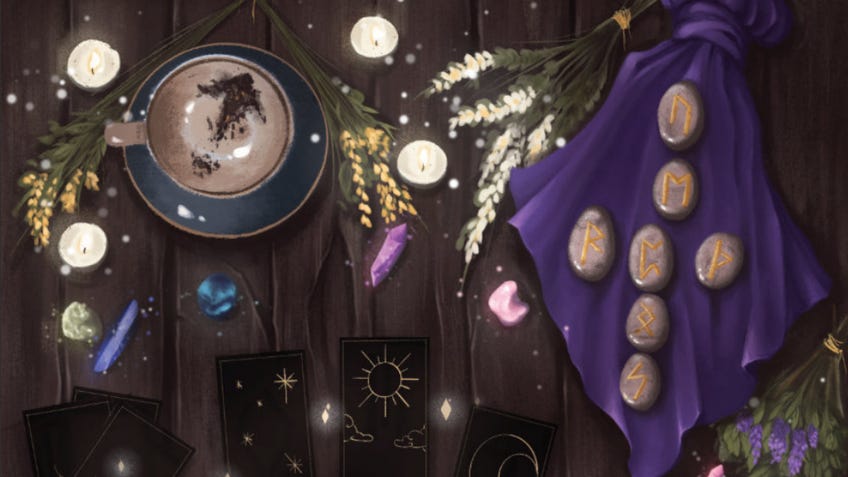A trio of witches save the world one person at a time in tender healing RPG The Mending Circle
Thaumaturgical therapy.
The Mending Circle believes in the power of rituals. From the beginning of this indie tabletop RPG to its closing moments, the trio of player-controlled witches engage in a kind of collaborative magic as the divine someone in need and turn their subtle but potent art towards dislodging their pain. Releasing on Halloween (October 31st), it’s a fascinating look at resistance through individual care that doesn’t back down from ugly truths.
Created by German designer Martin Nerukar of Sharkbomb Studios, The Mending Circle is a departure from previous titles, such as map-making game Ex Novo and card-based video game Nowhere Prophet. In the designer’s notes at the end of the book, Nerukar claims the process was “a deeply personal experience” because so much of their own personality and vulnerabilities run through the design and presentation.
The Mending Circle is meant for three players, a trio of witches - which the game defines as those individuals who can tap into the “connecting and creative force” of the universe. The player witches have been contacted by the omniscient Mothers to form a coven and seek out the Torn - someone experiencing emotional or mental pain to a degree that threatens to take over their life - and heal their Wound.
Nurturing that healing takes place during play, and The Mending Circle allows groups to construct the story together, asking questions of a rite - tarot cards, Oija board, stones, etc. - and drawing a wound sigil that will turn their magic towards eliminating the pain. Each three to four hour session will see the group address three Gaps to that sigil, keeping the Torn from achieving the necessary safety, peace and meaning that represent their acceptance of the witches’ magic. As each is overcome, the coven will connect the gaps in their sigil and eventually complete the ritual.
The coven will begin by introducing their witches before roughly sketching the nature of the Torn and their Wound and then heading out into their chosen world. What this looks like in action will depend on the group. Roleplay is left open, allowing for a number of approaches to fit the comfort level and storytelling expertise of each coven. Sessions will shift between free play, montage scenes and interrogations as each Gap is encountered, identified and overcome.
Though the ritual takes place in a shared space, the witches will need to go meet the individual they wish to heal and chat with them - trauma isn’t processed through the wave of a wand but through sympathy, understanding and reaching out at the right time. Active scenes see the coven investigate and ultimately address a Gap with a dice roll that relies on one of four stats - muscle, bone, head and heart - while challenge rolls are reserved for climactic scenes where the coven’s intervention feels pivotal to their mission.

A witch’s tools will differ depending on their chosen playsheet. Each of the eight archetypes, with names like The Nurturing or The Beacon, gives players access to a magical familiar, signature strengths, and magic charms they can use during scenes to affect change or encourage the Torn along their path. For example, The Playful can spend a charm to cause a bout of bad luck, while The Witness can ask how two people are connected and divine an answer from the group’s chosen rite.
The rules ask players to begin and end sessions through external rituals, laying hands on shoulders while humming or voicing aloud their intentions as they step from the real-word into fiction and back out again. All of this provides table dressing for the magical nature of the game but also allows the players the opportunity to reflect on their own emotions in a conscious and safe manner.
Nerukar clearly states that groups should encourage themselves to tackle thorny and complicated problems but accept the limits of their own individual abilities. Helping someone escape the prison of their anxiety or find community and material aid may not dismantle structural evils, but it is a victory worth celebrating. Even in failure, there is a ritual for destroying the Wound Sigil as a means of letting go of what was always impossible. Healing is a process, and defeat is not final. The choice to walk away from the game is also a collaborative one.
The Mending Circle can be found on Sharkbomb Studios’ website, where it will be released on October 31st as a 100-page book available as a digital download.


